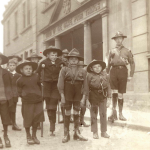It was an interesting project. During the sessions we’d looked at the history of disabled people in Bristol – who, the material suggested, had downtrodden, miserable and ignored lives – and also important buildings like The Guild of the Brave and Poor Things. We looked at them in an interactive and explorative way. This sheds light on a time in history that is not looked into much elsewhere, taught or advertised, which was very interesting.
Constructing a reality for our game
In the workshops we looked at the day to day lives of people connected to the Guild, what they would enjoy doing like we do today, what would’ve affected them and how events then may have made them feel.
We mapped out the places that may have been of importance to a lot of the people who’d attended The Guild at the time and related these spaces to gaming, especially what makes existing games engaging. This allowed us to think of the design for the crux of this game as well as thinking about how the history from the archive could make the game more engaging or how other game tools could make the history more engaging.
Digital games from local historical reality
Working with different mediums, like game design, to explore different historical times is always very eye-opening. This is especially true when it’s relevant to something that had taken place locally; the building of The Guild and the unprecedented positive, forward-looking charitable cause initiated by the founder. In her time, she planted the seeds for much-needed community.
It was fun incorporating the historical findings, the people and events and our own reflections into an enlightening game. Following in the footsteps of the Guild’s Founder, we also aim to make it accessible to all, which is a brilliant ambition.











